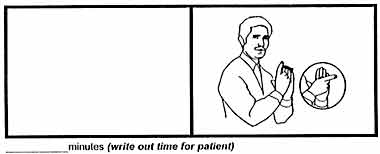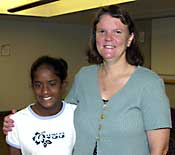REMARKS OF
Bill Lann Lee
Acting Assistant Attorney General
for Civil Rights
Connecticut Children’s Center
Hartford, Connecticut
July 28, 2000
*********
Ten Years of the ADA:
Pride in a Decade of Access,
Determination to Finish the Job of Accessibility for All
Thank you, Larry, for hosting all of us here at this beautiful facility.
The past two weeks have painted a vivid picture of why the ADA is so important. I had the privilege of going to Montgomery, Alabama, to participate in the Spirit of ADA Torch Relay. I stood where Dr. Martin Luther King stood on the steps of the State Capitol, across the street from his church. I stood with people with all types of disabilities and I was moved by their stories of how the ADA had made such a difference in their lives.
I am so pleased to be here today to tell another important ADA success story -- about equal access to hospital care in Connecticut for people who are deaf or hard of hearing. I'd like to thank those of you here who have made this day possible.
Thanks to Jim McGaughey. Your work in this case on behalf of the Connecticut Office of Protection and Advocacy is an inspiring example in the fight for equal access. The Commission for the Deaf and Hard of Hearing and the Connecticut Association of the Deaf also deserve our thanks. I would also like to thank Judge Smith, who is in the audience today, for his steadfast work in mediating the Avena case to a successful resolution.
Ten years ago, we enacted the Americans with Disabilities Act -- the most comprehensive civil rights law in our nation’s history. And great things followed. In the ten years the ADA has been on the books, opportunities for equality, independence, and inclusion have opened up in workplaces, businesses, and government agencies and offices across the country. The Clinton Administration has shown a firm, unflagging commitment to that effort. We have focused on the fundamentals. It’s no longer unusual to see people with disabilities participating in city council meetings, dining out at restaurants, watching a movie, or cheering at a stadium.
Access to hospital care is fundamental. Two years ago, we reached an agreement in Connecticut that serves as a model nationwide. It represents the hard, determined work of all involved, the United States Attorney, the Civil Rights Division, the Connecticut Office of Protection and Advocacy, and acute-care general hospitals in this State.
People who are deaf or hard of hearing told us that they were often not able to communicate effectively with hospital staffs. Hospitals told us that they often had trouble finding sign language interpreters who would come to the hospital on short notice. These real-world challenges needed a real-world solution.
At the urging of the Justice Department and the Office of Protection and Advocacy, and under the leadership of the Connecticut Hospital Association, the hospitals created an unprecedented network of on-call sign language and oral interpreters -- ensuring that people who are deaf or hard of hearing have the same access to hospital care as others. This innovative approach means that deaf parents such as June Freeman can bring their children to Connecticut Children’s Medical Center and other hospitals, knowing that they will be able to communicate effectively with their entire medical team. Deaf people benefit. Their family and friends benefit. Hospitals benefit. We all benefit. Better communication leads to better treatment. Access benefits everyone, and that is what the ADA is all about.
All of us knew that some of the challenges facing deaf patients and their medical teams did not have easy solutions. Especially during emergency situations, effective communication is essential. Medical staff often cannot wait until sign language interpreters arrive to find out whether a patient is allergic to certain medications, or when she ate her last meal. All of us knew we had to find a way to bridge the communication gap between those who use sign language and those who do not.
Today, I am extremely proud to announce the release of "Pictograms for Hospital Communication". This two-volume pictogram set is designed to be an integral part of communication between hospitals, and patients and family members who are deaf or hard of hearing. The pictograms illustrate phrases using sign language with captions written in English below the pictogram. Hospital staff can look up a phrase in English and point to the phrase in the pictogram notebooks, then show the pictogram to the deaf person.
The Connecticut Hospital Association surveyed its member hospitals for a list of the most frequently asked questions in emergency departments, admissions departments, and patient rooms. They range from simple questions like, "Where is the pain?" to more complex ones like, "Do you have any medical problems like hypertension?" Without the pictograms, it may be impossible for medical staff to ask these questions of someone who is deaf or hard of hearing until a qualified sign language interpreter arrives.
The pictograms cannot, of course, substitute for qualified sign language interpreters or any other particular auxiliary aids where they are needed to ensure effective communication. But they will be a tremendous help in the critical period after an interpreter has been called but before he or she arrives at the hospital. We have made 1,000 sets. One hundred will stay here in Connecticut. The rest will be distributed to hospital associations nationwide and hospitals in areas with large populations of people who are deaf or hard of hearing. Sign language is, by its nature, a very interactive, expressive language. It is challenging to translate it into the two-dimensional world of print. Also, there are some words commonly used in hospital settings that simply don’t translate easily into sign language. This innovative project is a work in progress. We welcome feedback from the deaf community and the medical community about how we can improve it to reach our shared goal -- to make sure that everyone is able to communicate fully and effectively in a hospital setting.
We have made great progress in opening doors to people with disabilities in the past 10 years, but we still have a long way to go. Attorney General Reno has often said that we will not stop until every door is opened. The President in his most recent budget asked Congress for a 35% increase in Justice Department ADA enforcement. These new funds are critical for the vigorous enforcement of our nation’s most comprehensive civil rights law. On Wednesday at the FDR Memorial, President Clinton spoke eloquently of the profound impact that the ADA, in its first decade, is having on our society. He said -- "We have liberated not only Americans with disabilities, but as Martin Luther King said of the civil rights movement so long ago, when people find their own freedom, those who have denied it to them for too long are, themselves, made more free. We are all a freer, better country because of the ADA."
Let us rededicate ourselves to the job we started with the ADA. Let us create a world where no one is denied access to the American dream.
Note:
("Pictograms for Hospital Communication" contains two volumes to facilitate communication with individuals using American Sign Language (ASL) and Contact Language, the two most common sign languages in the United States. Volume I is used with people who communicate primarily in American Sign Language. ASL has a unique syntax and structure pattern, and does not correlate one-to-one with written or spoken English syntax. Volume II is used with people who communicate with both American Sign Language and English. Contact Language is sign language that is formed as a result of interactions between deaf and hearing people and contains signs the exhibit features of both American Sign Language and English.)
Sample pictograms from Pictograms for Hospital Communication


From Signing: HOW TO SPEAKWITH YOUR HANDS by Elaine Costello, copyright 1983 by Elaine Costello. Used by permission of Bantam Books, a division of Random House, Inc. www.randomhouse.com
last updated July 28, 2000


